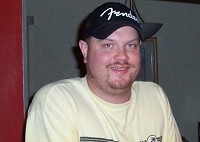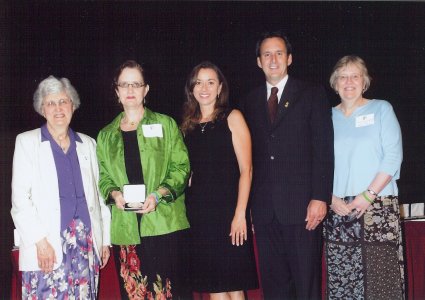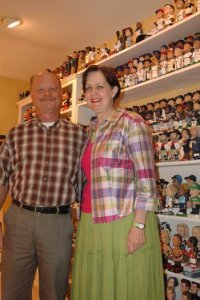LifeSource Article
The following article is reprinted from the Monticello Times:

| Wednesday,
July 19, 2006
At
the time of his death in April of last year, 30-year-old Monticello
High School graduate Jason Ray left behind a hefty legacy that included
a loving fiancÚ, family and many friends, an eclectic
accumulation of
eBay purchases, an impressive list of famous friends and business
associates, a collectors’ Web site of international renown
and a
world-class collection of more than 4,500 bobbleheads–many of
which he
created himself. But in the 15 months since he left this world, Jason’s legacy has expanded far beyond his life’s achievements, said his mother, through the gift of life he’s passed along to the living, by the donation of his body’s vital tissues. Jason’s parents, Steve and Linda Ray, were thanked by Governor and First Lady Tim and Mary Pawlenty for their decision to make that legacy possible, at a reception held June 15 at St. Paul’s Crowne Plaza Hotel. The event, attended by some 500 donor family members, representing 113 donors, was hosted by LifeSource, a nonprofit organization dedicated to saving lives through organ and tissue donation in the upper Midwest. Each donor family was presented with a medal of honor in recognition of their loved one by the Pawlentys, who are both active in the LifeSource program. The first couple also delivered speeches, Linda said, that were moving, powerful and much appreciated by their audience. Since losing her son, grief has been a part of her life, Linda said. But the decision she and her husband made on the night they lost him has brought both of them comfort on more than one occasion in the weeks and months since his death. “I’m glad we did it,” she told the Times. “It was easy to make the decision for Jason. He was a generous per-son–loved to share, loved finding the perfect gift. This is just one more piece of his little story.”
Linda and Steve lived every parent’s nightmare on that fateful April day: the notification by Wright County patrol officers, the drive to Sandstone, the documentary details and the desolate return to Monticello. It was about 10:30 p.m., she recalled, that they got a call at their home from LifeSource. “We actually gave permission over the phone,” she said. “Steve took the call. We’d been approached at the hospital in Sandstone, but they hadn’t been able to reach us, and he had no living will. And it was already too late to use his organs.” But as it turned out, she continued, that was not the case with Jason’s tissues. “You have a choice which tissues you want to donate,” Linda said. “They went through the list, item by item. It was so hard, because I could hear them listing off skin, veins, heart valves, eyes, bone–when they got to bones, I don’t know why, but that just hurt me the most.” Nevertheless, she and Steve elected then and there to donate all of their son’s usable tissues. “We checked everything off,” she said simply.
According
to statistics provided by LifeSource, in the time it takes you to scan
the morning’s headlines, one name has been added to the
national organ
transplant waiting list. By the time you get a cup of coffee and check
your e-mail, another name has been added to the list. Every day, more than 100 names are added to that list, yet only about 74 transplants take place. This difference has created a national waiting list that now tops more than 90,000 individuals. And 17 of them die each day as they wait for the call that will save their life. While support for donation in the United States continues to grow, data indicates there is still considerable room for improvement. Findings from a 2005 University of Minnesota state survey show that 96 percent of Minnesotans support donation; however, data from the Minnesota Department of Public Safety shows that only 43 percent of Minnesotans have “donor” marked on their driver’s license or ID card. One of the goals of LifeSource is to make donation the societal norm. The U of M survey indicates that the disparity is due to individuals who “haven’t gotten around to it” (27 percent), followed closely by people who cite their personal health problems (22.6 percent) as reasons they haven’t channeled their support into action. Donation officials say both reasons are commonly cited as barriers to donation. But, says LifeSource, individuals who believe they would not be acceptable donors based on medical reasons do, in fact, have the potential to save lives through donation. In a press release issued by LifeSource, the organization’s CEO, Susan Gunderson, states, “Everyone should consider themselves a potential donor with the ability to save lives, and let the medical professionals at the time of death decide what organs and tissues are healthy enough to be transplanted.” In Jason’s case, LASIK surgery he’d had on his eyes prevented his corneas from being useful for transplant; however, Linda pointed out, his eyes–which were donated to the Minnesota Lions’ eye bank–proved to be useful in research for the prevention and correction of macular degeneration. “That was so meaningful to me, when we went to an eye bank event and learned about the importance of this research,” she said. “That was very, very powerful to both of us.” As to the destination points of the various contents of Jason’s living legacy, Linda is less certain. “It’s kind of up to the doctor to follow through,” she said. “You don’t always find out.” A large share of that decision, she explained, also rests with the donation’s recipient. “People feel so grateful, but so sad that someone died so they could live,” she said. “It’s so hard to write a thank-you letter.”
“That’s the wonderful part,” she said. “It’s kept for up to four years. Using tissue from one person, they’re able to help up to 60 people.” Her own 20-year-old niece, Linda attested, recently benefited from tissue replacement involved in a knee surgery. The LifeSource staff, she said, was sensitive to their emotional state, providing information and understanding, through the donation process and beyond. “They gave us wonderful personal support,” she said. “Jill Halimi, our family services director, was so helpful. And they provide grieving pamphlets and hold gatherings twice a year, and they send you letters on anniversaries. They gave us plenty of time, and when they made their request, they very kindly, carefully asked us if we would consider that. It was hard, but it was all good, too.” Though her son has taken leave of this world, Linda said she and her husband take comfort in his life-giving legacy. A disc golf tournament he started will be held in August at the Sumac Hills Disc Golf course in Barrett, where a bronze marker stands in his honor. His memorial fund has provided his family with several needs, including leg braces for a cousin with cerebral palsy and an electric garage door opener for an aunt who recently underwent a double mastectomy. The bobblehead dolls he so lovingly created enhance the collections of thousands. And the gift of living tissue Linda and Ray donated on his behalf will prolong the lives of countless more. “To know Jason’s short life is still helping others does give us great comfort,” Linda said, “because that was Jason’s heart. He was always helping people. It’s a wonderful program. I’m fully supportive of it. I have signed my driver’s license for that now. I did it when I got it renewed. That’s the best way.” And, as she and LifeSource both stress, while it’s helpful to check the box on your driver’s license, it’s equally important to share your decision with your loved ones. “Tell your family that’s what you want,” Linda advised. “That way, they don’t have to make the decision–you already have. It would’ve been easier if we had talked about it before–with a sudden tragedy, there’s no time to think. It is hard, but it’s also very helpful to know what someone wants. Do more than think about it. Talk about it, and decide.” For more information about organ and tissue donation, call LifeSource toll-free at 1-800-5-DONATE, or visit www.organdonation.org. | |||||||



